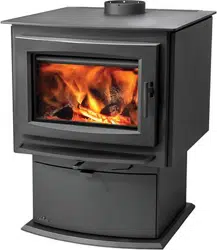Loading ...
Loading ...
Loading ...

W415-1476 / A / 09.30.16
27
EN
8.2 CREOSOTE FORMATION AND REMOVAL
84.1A
When wood is burned slowly, it produces tar and other organic vapors, which combine with expelled moisture
to form creosote. The creosote vapors condense in the relatively cooler chimney fl ue of a slow-burning fi re. As
a result, creosote residue accumulates on the fl ue lining. When ignited this creosote makes an extremely hot
fi re.
The chimney connector and chimney should be inspected at least once every two months during the heating
season to determine if a creosote buildup has occurred.
If creosote has accumulated it should be removed to reduce the risk of a chimney fi re.
8.3 RUNAWAY OR CHIMNEY FIRE
85.1
Runaway fi res can be the result of three major factors:
• Using incorrect fuel, or small fuel pieces which would normally be used as kindling.
• Leaving the door ajar too long and creating extreme temperatures as the air rushes in the open door.
• Burning your appliance with the ash plug not securely seated.
SOLUTIONS:
• Do not burn treated or processed wood, coal, charcoal, coloured paper or cardboard.
• Be careful not to over-fi re the appliance by leaving the door open too long after initial start-up. A
thermometer on the chimney connector and/or appliance top helps.
• Always operate the appliance with the ash plug properly installed.
IN CASE OF A CHIMNEY FIRE:
• Have a well understood plan for evacuation and a place outside for everyone to meet. Prepare to
evacuate to ensure everyone’s safety.
• Close air control on appliance.
• Call local fi re department. Have a fi re extinguisher handy. Contact local authorities for further
information on how to handle a chimney fi re.
• After the chimney fi re is out, clean and inspect the chimney for stress cracks prior to lighting another
fi re. Also check combustibles around the chimney and the roof.
!
WARNING
A CHIMNEY FIRE CAN PERMANENTLY DAMAGE YOUR CHIMNEY SYSTEM. THIS DAMAGE CAN
ONLY BE REPAIRED BY REPLACING THE DAMAGED COMPONENT PARTS. CHIMNEY FIRES ARE
NOT COVERED BY THE LIFETIME LIMITED WARRANTY.
8.4 CHIMNEY CLEANING
86.1
Both the chimney and the appliance must be inspected and cleaned if necessary at least once a year.
For serious wood burners, chimney cleaning must be done as needed to avoid chimney fi res; the venting
systems for controlled combustion appliances may need cleaning as often as once a month. These rates,
however, depend on the burning habits of the individual operating the appliance. For example, it is possible to
clog a solid fuel appliance chimney in a few days if slow, smoldering fi res are burned and the chimney is cold.
NOTE: Appliances burned consistently without hot fi res may result in signifi cant creosote
accumulations in the chimney.
Certain items and considerations are important in chimney cleaning:
• Proper tools should be used, including a brush specifi cally designed for chimney cleaning.
• The chimney connector and dampers as well as the chimney should be cleaned.
• The appliance’s fi rebox and baffl e system should be cleaned if needed.
• The chimney should be inspected and repairs made if needed, preferably by a qualifi ed chimney
sweep or mason.
Loading ...
Loading ...
Loading ...
